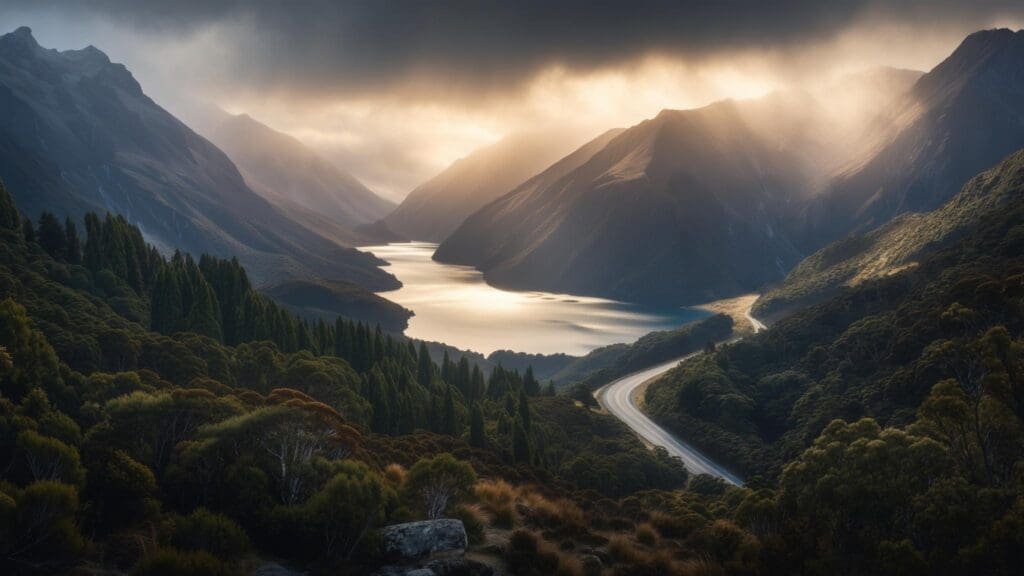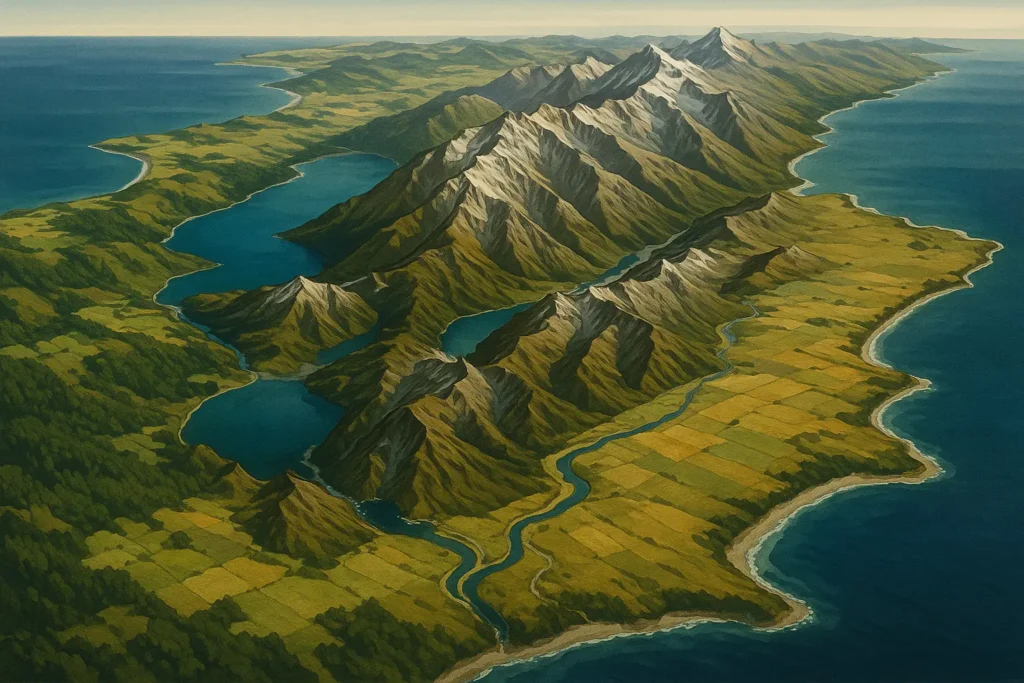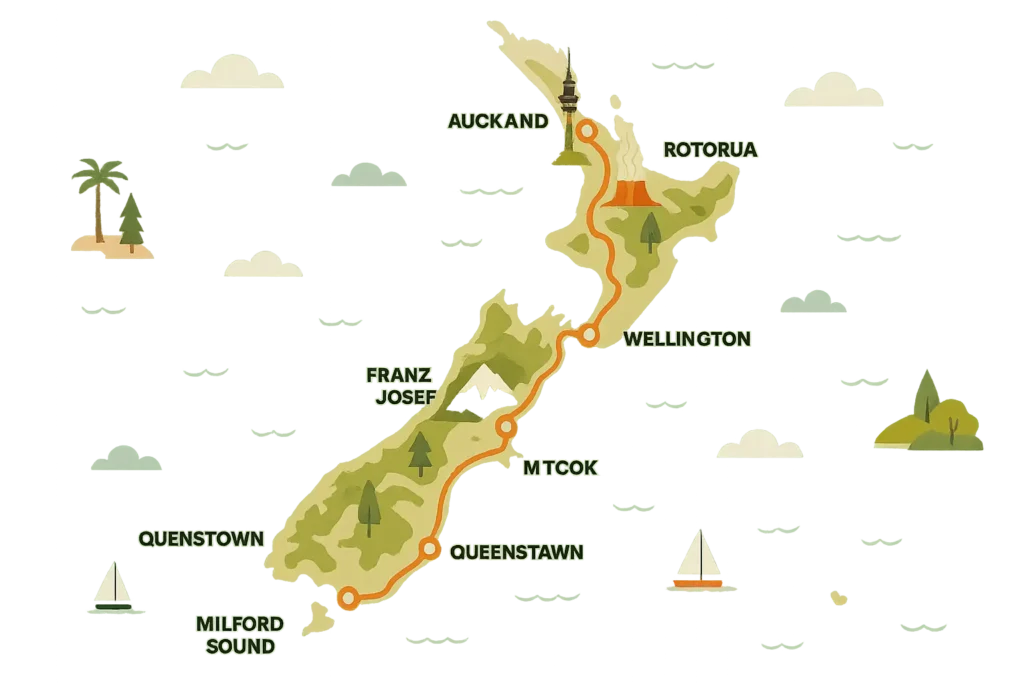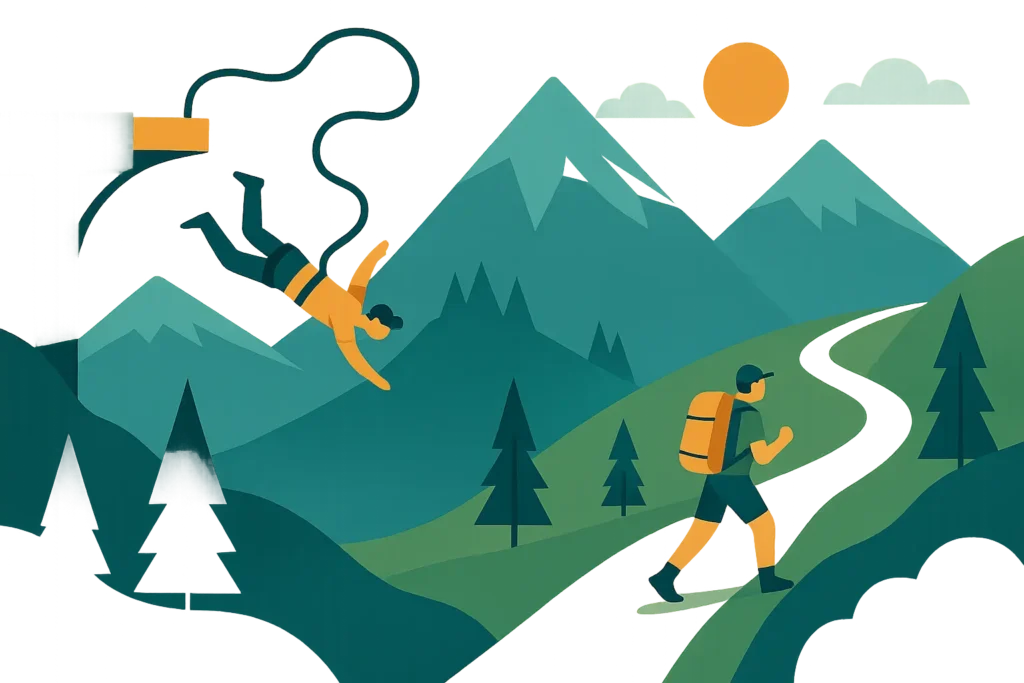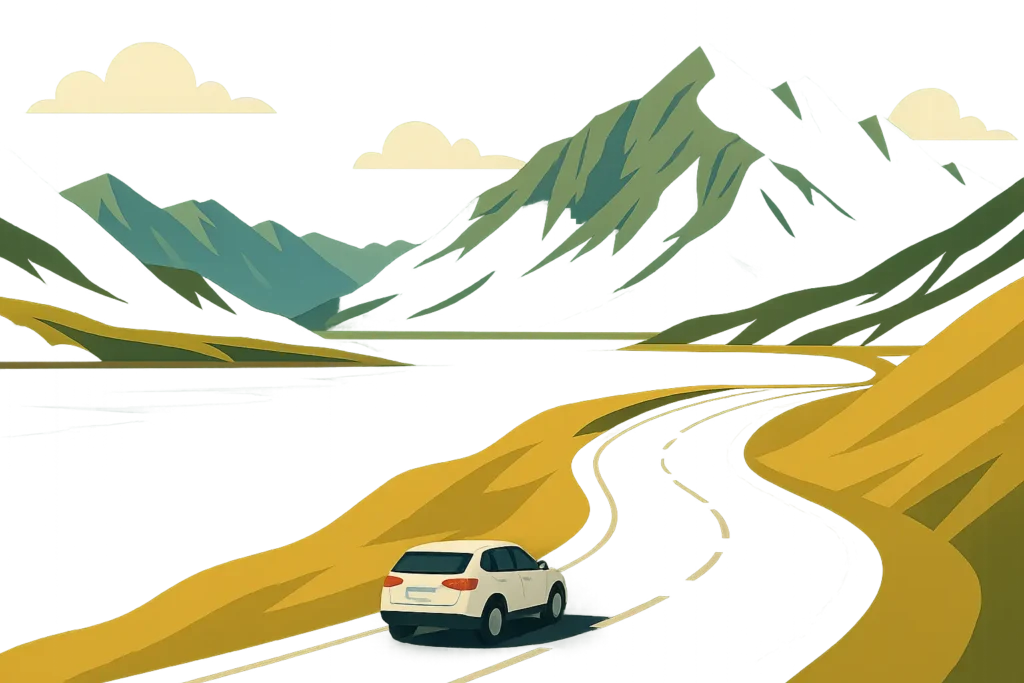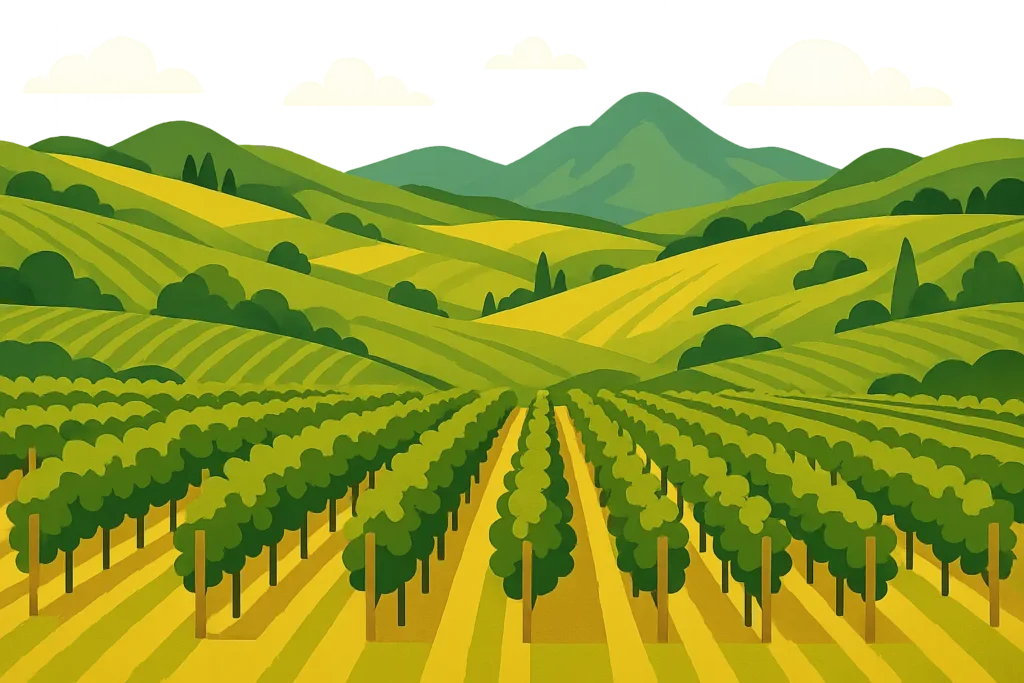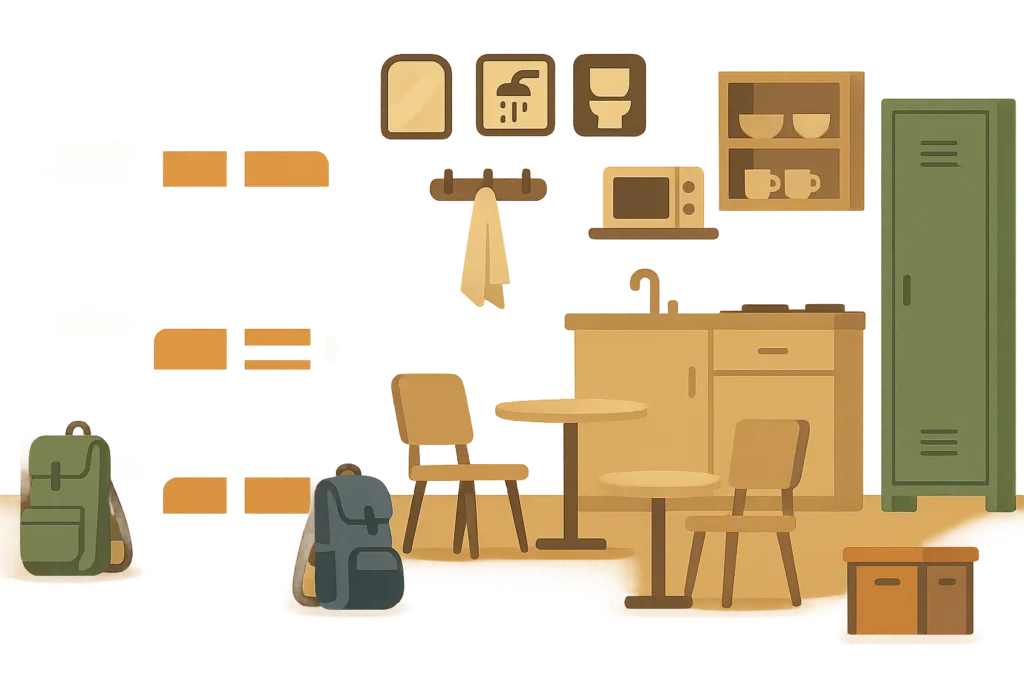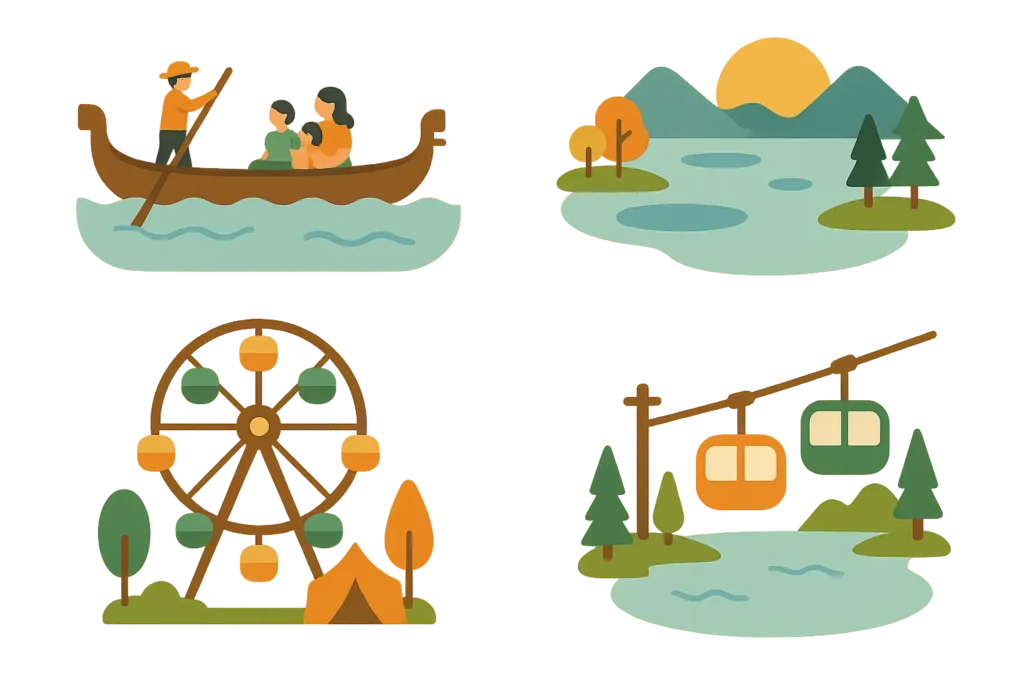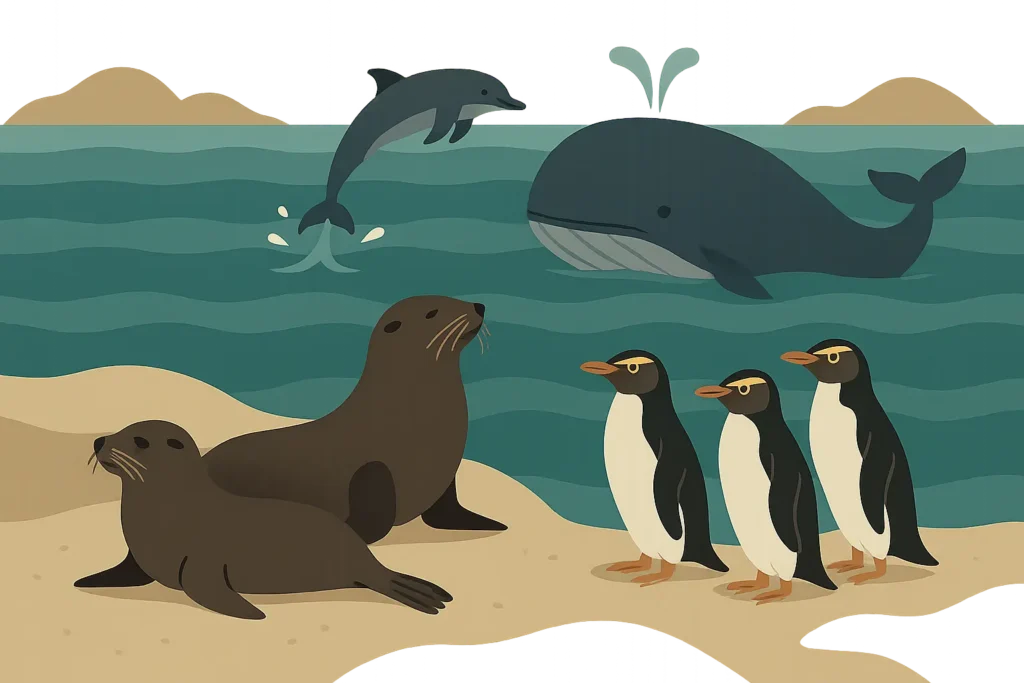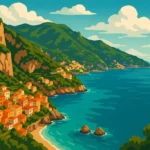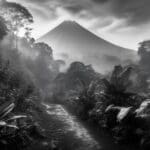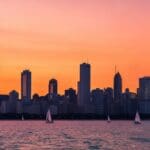I’ll be brutally honest – when I first started planning my New Zealand trip, I spent three weeks going down internet rabbit holes and ended up with 47 browser tabs open and a mild panic attack. Sound familiar? The sheer number of incredible things to do in New Zealand can be paralyzing, which is exactly why I’m sharing these 25 new zealand itinerary options that actually make sense.
Feeling overwhelmed by options? Use our Vacation Planner to turn your dream trip into an organized, stress-free itinerary in minutes.
New Zealand attracts over 3.9 million international visitors annually, with most spending 2-3 weeks exploring both islands according to Tourism New Zealand data. Look, I’m going to save you from making the same mistakes I did. Here’s what actually matters when planning your new zealand itinerary (and what you can totally ignore despite what travel forums tell you).
Quick Resources:
-
Plan your perfect adventure with our Vacation Planner
-
Create your ideal honeymoon or couple’s trip using our Honeymoon Planner
-
Simplify group adventures with our Bachelorette Party Planner
-
Explore all our Wedding & Travel Tools
TL;DR
- New Zealand offers 25+ distinct itinerary styles ranging from 7 days to 4+ weeks
- Two weeks provides the sweet spot for first-time visitors to experience both islands
- Budget travelers can explore for $80-120 NZD daily while luxury experiences start at $300+ NZD
- Adventure itineraries require advance bookings, especially for Great Walks and extreme sports
- Road trip itineraries offer maximum flexibility but require left-side driving adjustment
- Seasonal timing dramatically affects pricing, crowds, and activity availability
- Cultural itineraries provide deep Māori heritage experiences beyond typical tourist attractions
- Family-friendly options focus on safe, engaging activities for children 5-15 years old
- Luxury lodge circuits include private transfers, exclusive experiences, and gourmet dining
- Off-season travel (autumn/spring) offers excellent weather with fewer crowds and better prices
Planning Your Perfect New Zealand Adventure
Fair warning: you will get FOMO. There’s literally no way to see everything New Zealand has to offer in one trip, and that’s okay. Duration, timing, geographic coverage, transportation methods, budget considerations, activity preferences, and practical logistics all play crucial roles in selecting the right new zealand itinerary.
Most travelers underestimate the importance of seasonal considerations – New Zealand’s opposite seasons mean summer (December-February) brings crowds and high prices, while autumn (March-May) offers the best balance of weather and value. I learned this lesson the hard way after paying premium prices for accommodations during peak season when shoulder season would have delivered the same experiences at half the cost.
Not sure when to go? Let our Vacation Planner build your personalized timeline based on seasons, budgets, and ideal activities.
Understanding Duration and Timing
Trip length fundamentally shapes your New Zealand experience. Seven-day trips require laser focus on specific regions or themes. Ten-day itineraries allow comfortable exploration of major highlights across both islands.
Two weeks represents the gold standard for first-time visitors – enough time to experience diverse landscapes, cultures, and activities without feeling rushed. This two week new zealand itinerary strikes the perfect balance between comprehensive coverage and manageable pacing. Three-week adventures open doors to remote locations and deeper cultural immersion. Month-long journeys let you truly understand New Zealand’s regional differences and seasonal variations.
Seasonal timing affects everything from accommodation prices to activity availability. Summer brings perfect weather but also brings tour buses and inflated costs. Winter transforms the South Island into a skiing paradise while limiting some outdoor activities. Spring and autumn offer the sweet spot – moderate weather, reasonable prices, and manageable crowds.
| Season | Weather | Crowds | Pricing | Best Activities |
|---|---|---|---|---|
| Summer (Dec-Feb) | Warm & Dry | High | Premium | Hiking, Beaches, Outdoor Sports |
| Autumn (Mar-May) | Mild & Stable | Moderate | Good Value | Photography, Wine Tours, Hiking |
| Winter (Jun-Aug) | Cool & Wet | Low | Budget-Friendly | Skiing, Hot Springs, Indoor Culture |
| Spring (Sep-Nov) | Variable | Low-Moderate | Good Value | Wildflowers, Mild Adventures |
Geographic Coverage Strategies
Each island offers distinctly different experiences. The North Island showcases geothermal wonders, vibrant Māori culture, and cosmopolitan cities. Rotorua’s bubbling mud pools and cultural performances contrast sharply with Auckland’s harbor views and Wellington’s artistic energy.
The South Island delivers dramatic alpine scenery, pristine fjords, and adventure sports capital Queenstown. Franz Josef Glacier, Milford Sound, and the Southern Alps create Instagram-worthy moments at every turn. Most comprehensive itineraries include both islands, but single-island focus allows deeper exploration. Transportation between islands adds time and cost but rewards you with complete geographic diversity.
Budget and Transportation Considerations
Your transportation choice dramatically impacts both cost and experience quality. Rental cars provide maximum flexibility and access to remote locations. Organized tours offer convenience and local expertise. Public transport works for budget-conscious travelers but limits accessibility to some attractions.
Yes, New Zealand is expensive. No, you probably can’t do it for the same budget as your Thailand trip. But here’s how to make it worth every penny… Budget ranges vary dramatically based on accommodation style, dining choices, and activity selection. Backpackers can manage on $80-120 NZD daily using hostels and self-catering. Mid-range travelers spending $150-250 NZD enjoy comfortable motels and restaurant meals. Luxury experiences starting at $300+ NZD include premium lodges and exclusive activities.
Sarah’s Planning Success Story: “I initially planned a 10-day trip trying to see everything, but after reading this guide, I chose the 2-week Essential New Zealand itinerary instead. By focusing on both islands’ highlights rather than rushing through everything, I actually experienced more meaningful moments and didn’t feel exhausted. The extra four days made all the difference in truly appreciating each destination.”
Find your perfect balance like Sarah did — plan smarter, not harder, with our Vacation Planner.
Classic First-Timer Routes
These five itineraries represent the most popular and well-tested routes for New Zealand newcomers. They balance must-see attractions with practical logistics, ensuring you experience the country’s highlights without overwhelming complexity. Each option caters to different time constraints while maintaining comprehensive geographic coverage and cultural exposure.
If you’re reading this at 2 AM because you can’t decide between options, just pick the 2-week Essential new zealand itinerary. Seriously. You can always extend or modify it later. I’ve personally tested variations of each route and can confidently say they deliver exactly what first-time visitors need – a perfect introduction to this incredible country.
1. The Grand Tour – 3 Weeks
The ultimate comprehensive New Zealand experience covering both islands’ major highlights and hidden gems. This new zealand trip itinerary provides sufficient time to experience diverse landscapes, cultures, and activities without feeling rushed. Perfect for first-time visitors wanting complete coverage or those celebrating special occasions with extended travel time.
This three-week journey begins in Auckland with city exploration and Waiheke Island wine tours. You’ll experience the Bay of Islands’ dolphin watching and Waitangi Treaty Grounds before diving into Rotorua’s geothermal wonders and Māori cultural performances.
Week two transitions through Taupo’s lake activities and Tongariro National Park hiking before reaching Wellington’s museums and harbor views. The Interislander ferry crossing to Picton marks your South Island adventure beginning with Marlborough wine region exploration. Your final week showcases Franz Josef Glacier helicopter tours, Queenstown’s adventure activities, and the breathtaking Milford Sound day trip. Wanaka’s lakeside serenity provides perfect contrast to Queenstown’s energy before your Christchurch departure.
Transportation: Rental car with ferry crossing
Budget: $4,500-6,000 NZD per person
Best For: First-time visitors wanting comprehensive coverage
2. Essential New Zealand – 2 Weeks
This two week new zealand itinerary is popular because it just works. It’s like the perfect jeans of New Zealand itineraries – fits most people, looks good, and you won’t regret it. This route efficiently covers major highlights while allowing sufficient time to appreciate each destination without rushing.
Week one focuses on North Island essentials: Auckland’s Sky Tower and harbor bridge, Waitomo Caves’ glowworm experience, Rotorua’s geothermal parks and cultural performances, Taupo’s lake activities and Huka Falls, plus Wellington’s capital city highlights.
Week two delivers South Island adventures starting with the scenic ferry crossing to Picton. Abel Tasman National Park’s golden beaches lead to Franz Josef Glacier exploration and helicopter tours. Your journey culminates in Queenstown’s adventure capital activities and stunning alpine scenery. This itinerary strikes the perfect balance between structured planning and flexibility.
Transportation: Rental car with ferry
Budget: $3,000-4,500 NZD per person
Best For: Balanced first-time experience
3. Highlights Express – 10 Days
A well-curated essentials tour perfect for travelers with limited vacation time but maximum enthusiasm. This new zealand trip itinerary efficiently covers both islands’ major attractions using strategic flight connections and focused regional exploration.
North Island highlights include Auckland’s urban attractions, Rotorua’s geothermal wonders, and Wellington’s cultural offerings. Strategic flight connections maximize your time while minimizing travel fatigue. South Island adventures feature Christchurch’s post-earthquake renewal, Franz Josef Glacier’s icy magnificence, and Queenstown’s three-day adventure immersion. Each destination receives focused attention without overwhelming your schedule.
Transportation: Mix of flights and rental car
Budget: $2,500-3,500 NZD per person
Best For: Time-constrained travelers seeking maximum impact
4. North Island Introduction – 1 Week
A thorough exploration of New Zealand’s North Island, perfect for travelers wanting deep regional focus rather than surface-level coverage of both islands. This itinerary showcases the island’s unique geothermal features, Māori culture, and diverse landscapes from beaches to volcanic plateaus.
Your journey begins in Auckland with harbor exploration and city highlights before heading north to the Bay of Islands. Dolphin watching, historic Waitangi Treaty Grounds, and pristine beaches provide perfect introduction to New Zealand’s natural beauty.
Rotorua delivers the quintessential New Zealand experience with bubbling mud pools, shooting geysers, and authentic Māori cultural performances. Wellington concludes your week with capital city sophistication, Te Papa Museum, and harbor views.
Transportation: Rental car or bus tours
Budget: $1,500-2,200 NZD per person
Best For: Cultural enthusiasts and geothermal lovers
5. South Island Spectacular – 1 Week
Concentrated adventure and scenery focusing exclusively on the South Island’s dramatic landscapes and outdoor activities. This new zealand itinerary maximizes alpine experiences, glacier encounters, and adventure sports while maintaining manageable pacing for a one-week timeframe.
Christchurch provides your gateway to South Island adventures with post-earthquake renewal stories and garden city charm. Franz Josef Glacier offers two days of ice exploration through helicopter tours and valley walks. Queenstown delivers three days of adventure capital excitement with bungy jumping, jet boating, and scenic gondola rides. Wanaka’s lakeside tranquility provides perfect contrast and relaxation before departure.
Transportation: Rental car
Budget: $1,800-2,500 NZD per person
Best For: Adventure seekers and alpine scenery lovers
Adventure & Outdoor Expeditions
These four itineraries cater to travelers seeking physical challenges, adrenaline rushes, and outdoor immersion. From extreme sports circuits to multi-day hiking adventures, each option requires good physical fitness and advance planning. These experiences showcase New Zealand’s reputation as the adventure capital of the world while providing access to pristine wilderness areas.
I’ll be
I’ll be honest – these new zealand road trip adventures aren’t for everyone. They demand physical preparation, mental readiness for challenging conditions, and often require booking months in advance. But if you’re up for the challenge, they deliver experiences that will stay with you forever.
6. Adrenaline Junkie’s Dream – 2 Weeks
Let me be real with you – this itinerary is not for the faint of heart or anyone who thinks a roller coaster is “too intense.” I’m talking about the kind of trip where you’ll question your life choices while dangling upside down from a bridge, then immediately want to do it again.
Week one kicks off with Auckland’s harbor bridge climb (which sounds scarier than it is, but don’t tell anyone I said that). Then you’re off to Waitomo for black water rafting – basically floating through underground caves in a wetsuit while trying not to think about what’s swimming around your feet. Rotorua delivers the goods with white water rafting that’ll have you screaming things you didn’t know you could say, plus zorbing (rolling downhill in a giant hamster ball because apparently that’s a thing humans do for fun).
Week two is where things get properly mental. South Island doesn’t mess around – we’re talking about the place where bungy jumping was literally invented. Queenstown is like Disneyland for people whose idea of fun involves potential death. Canyon swings, paragliding, jet boats that do 360-degree spins just because they can.
Real talk: You need to be in decent shape for this. I don’t mean Instagram-fitness-model shape, but you should be able to climb stairs without getting winded. Also, book everything in advance – like, months in advance. Popular slots fill up faster than you can say “hold my beer.”
Transportation: Rental car (and maybe some prayers)
Budget: $4,000-5,500 NZD per person (plus therapy costs afterward)
Best For: People who think “safety first” is just a suggestion
7. Great Walks Explorer – 3 Weeks
Okay, this one’s for the serious hikers. And when I say serious, I mean people who own more than one pair of hiking boots and actually know what “wicking fabric” means. If your idea of roughing it is a hotel without room service, maybe skip this one.
The Great Walks are New Zealand’s crown jewels of hiking – think of them as the Beyoncé of walking tracks. They’re stunning, everyone wants to experience them, and tickets are harder to get than concert seats. The Milford Track alone requires booking 6+ months ahead, and I’m not exaggerating. I once waited until 3 months out and ended up on a waitlist behind approximately half of Germany.
Here’s what nobody tells you: these walks are incredible, but they’re also work. Real work. The kind where you’ll wake up wondering why you chose this over a nice beach vacation. But then you’ll see a sunrise over Fiordland that makes you forget you can’t feel your feet, and suddenly it all makes sense.
| Great Walk | Duration | Difficulty | Best Season | Booking Required |
|---|---|---|---|---|
| Milford Track | 4 days | Moderate-Hard | Oct-Apr | 6+ months ahead |
| Routeburn Track | 2-4 days | Moderate | Oct-May | 4+ months ahead |
| Abel Tasman Coast | 1-5 days | Easy-Moderate | Year-round | 2+ months ahead |
| Tongariro Northern Circuit | 3-4 days | Moderate-Hard | Oct-May | 3+ months ahead |
| Kepler Track | 3-4 days | Moderate | Oct-Apr | 4+ months ahead |
The huts are actually pretty decent – think summer camp for adults but with better views and fewer mosquitoes. Most include basic bedding and cooking facilities, though “basic” is the operative word here. Pack light, but not so light that you freeze your butt off at night.
Requirements: Ability to walk for 6+ hours daily while carrying everything you need to survive
Transportation: Shuttles, boats, and your own two feet
Budget: $3,500-5,000 NZD per person (worth every blister)
8. Extreme Sports Circuit – 10 Days
This is the “greatest hits” version of the adrenaline itinerary – all the heart-stopping fun with less time commitment. Perfect for people who want to feel alive but also need to get back to their desk job.
Queenstown is your home base because it’s basically the world capital of “hold my beer and watch this.” You’ll bungy jump from multiple locations (because apparently once isn’t enough for some people), raft down rapids that have names like “The Terminator” (comforting, right?), and jump out of perfectly good airplanes.
The beauty of this circuit is that everything’s concentrated, so you’re not spending half your time driving between activities. The downside? You might peak on adrenaline overload by day three. I’ve seen grown adults crying tears of joy and terror simultaneously after their third extreme sport of the day.
Fair warning: Your Instagram followers will either love you or think you’ve lost your mind. Possibly both.
Transportation: Tours and rental car
Budget: $3,000-4,200 NZD per person
Best For: Commitment-phobes who want maximum thrills in minimum time
9. Hiking & Trekking Focus – 2 Weeks
This is for people who genuinely love hiking – not just the Instagram photos afterward, but the actual walking part. If you’re the type who gets excited about trail markers and debates the merits of different backpack brands, this one’s calling your name.
You’ll tackle portions of the Great Walks (the parts you can actually get bookings for), plus some lesser-known gems that locals don’t want tourists to know about. The variety is incredible – one day you’re walking through ancient forests, the next you’re scrambling over alpine rocks wondering why you didn’t just stay home and watch nature documentaries.
Accommodation ranges from backcountry huts (think “rustic charm” meets “did I pack enough toilet paper?”) to comfortable lodges where you can actually shower off the day’s adventures. The huts are an experience in themselves – there’s something weirdly bonding about sharing a basic shelter with strangers who are all equally tired and slightly smelly.
Pro tip: Your feet will hate you for the first few days, then forgive you when they see the views. Good boots aren’t optional – they’re the difference between loving this trip and limping through it.
Transportation: Mix of shuttles and rental car
Budget: $2,800-4,000 NZD per person
Best For: People who find peace in putting one foot in front of the other for hours at a time
Cultural & Scenic Road Trips
Here’s where New Zealand really shines – when you slow down enough to actually see what you’re driving past. These new zealand road trip options are for people who understand that sometimes the journey really is more important than the destination, even if that sounds like something from a motivational poster.
Road trips offer unmatched freedom to discover hidden gems and spontaneous stops that organized tours simply can’t provide. I’ve found some of my most memorable New Zealand moments happened during unplanned detours – stumbling upon a local farmers market or finding a secluded beach that wasn’t on any guide.
10. Ultimate New Zealand Road Trip – 4 Weeks
This is the “I’m going to see absolutely everything and I don’t care if it takes a month” trip. It’s comprehensive, exhausting, and absolutely incredible if you have the time and stamina for it.
Four weeks sounds like a lot until you realize New Zealand has packed the scenery of an entire continent into a space roughly the size of Colorado. You’ll drive over 4,000 kilometers, which sounds impressive until you’re on your third day of winding mountain roads and questioning your life choices.
Whether it’s two weeks or four, our Vacation Planner helps you map every stop, route, and must-see along the way.
Week one explores Northland and Auckland regions with Cape Reinga’s spiritual significance, Ninety Mile Beach adventures, and Bay of Islands maritime history. Auckland and Waiheke Island provide urban sophistication and wine experiences.
Week two covers Central North Island’s Coromandel Peninsula beaches, Rotorua’s geothermal wonders, Taupo’s lake activities, and Tongariro’s volcanic landscapes. Each region receives thorough exploration with hidden gem discoveries. Week three transitions to South Island’s West Coast via Wellington and Picton ferry crossing. Marlborough Sounds, Punakaiki Pancake Rocks, and glacier regions showcase dramatic landscape changes and remote beauty.
Week four concludes with Southern Alps exploration, Fiordland adventures, Canterbury region discoveries, and Christchurch departure. This comprehensive journey covers over 4,000 kilometers of diverse terrain.
The beauty of having this much time is that you can actually stop when something catches your eye instead of driving past thinking “oh well, maybe next time.” Found a cool-looking beach? Stop. Spotted a random farmers market? Why not. See a sign for “World’s Largest Something”? Obviously you’re going.
Reality check: By week three, you might be a little road-tripped out. Plan some rest days or you’ll end up seeing the most beautiful scenery in the world through exhausted, cranky eyes.
Transportation: Rental car or campervan (campervans are slower but you can stop literally anywhere)
Budget: $5,000-7,000 NZD per person
Best For: People with flexible schedules and strong bladders
11. Lord of the Rings Trail – 2 Weeks
Confession: I wasn’t even a huge LOTR fan before I did this trip, but standing in the actual Shire will convert even the most casual viewer. There’s something magical about seeing these places in real life, even if you know it’s all movie magic.
Hobbiton in Matamata is the crown jewel – they’ve kept the entire set intact, and it’s honestly better than the movies made it look. The attention to detail is insane. They have 44 hobbit holes, each with its own personality, and the guides tell stories that’ll make you appreciate just how much work went into creating Middle-earth.
Your journey begins at Hobbiton Movie Set in Matamata with guided tours through the Shire’s rolling green hills. Rotorua’s Redwood Forest doubles as Fangorn Forest, while Mount Doom scenes were filmed around Tongariro National Park.
Wellington showcases Weta Workshop’s movie magic creation process and Rivendell’s Kaitoke Regional Park location. South Island adventures include Edoras filming location near Mount Sunday, Helm’s Deep at Dry Creek Quarry, and Isengard’s stunning Nan Curunir valley. Queenstown region provides multiple filming locations including Ithilien Camp, Amon Hen, and the Misty Mountains.
But here’s the thing nobody tells you: a lot of the “filming locations” are just… really pretty places in New Zealand. Which is fine! They’re gorgeous! But don’t expect every location to scream “THIS IS WHERE FRODO WALKED!” Some require serious imagination to connect to the movies.
Movie Location Discovery: At Hobbiton in Matamata, you’ll walk through 44 authentic hobbit holes built specifically for the films. The Green Dragon Inn serves real ale and food from the movies, while guides share behind-the-scenes stories about how sheep were trained to run across the bridge on cue and how the Party Tree was replanted multiple times to achieve the perfect look.
Nerd level required: Medium to high. You’ll get more out of this if you actually remember the movies.
Transportation: Rental car with specialized tour components
Budget: $3,500-5,000 NZD per person
Best For: Anyone who’s ever wanted to live in the Shire (so, basically everyone)
12. Wine & Dine Road Trip – 10 Days
This is my kind of new zealand road trip – the kind where “research” involves tasting wine at 11 AM and calling it cultural education. New Zealand’s wine regions are world-class, and the food scene has exploded in recent years.
Marlborough’s Sauvignon Blanc is famous for good reason – it’s crisp, clean, and goes perfectly with the region’s incredible seafood. But here’s a secret: try the Pinot Gris too. It’s less famous but equally delicious.
Central Otago around Queenstown produces Pinot Noir that rivals anything from Burgundy, and the vineyard settings are arguably more spectacular. Nothing beats sipping wine while looking at snow-capped mountains, trust me.
Marlborough region launches your wine journey with Sauvignon Blanc tastings at renowned vineyards and boutique cellar doors. Blenheim provides your base for exploring over 140 wineries across the region.
Central Otago delivers exceptional Pinot Noir experiences around Queenstown and Wanaka. Vineyard restaurants offer wine-paired dining with alpine views and seasonal menus featuring local ingredients. Hawke’s Bay and Martinborough round out your wine education with diverse varietals and historic wine estates.
Important note: Designated driver arrangements are crucial. New Zealand takes drunk driving seriously, and the penalties are no joke. Many wineries offer transportation or you can book tours, but plan ahead.
Transportation: Rental car with very careful planning around alcohol consumption
Budget: $2,800-4,200 NZD per person (not including the wine you’ll inevitably ship home)
Best For: People who consider wine tasting a legitimate form of exercise
13. Māori Cultural Journey – 1 Week
This itinerary requires a mindset shift from typical tourism. You’re not just observing Māori culture – you’re being invited to learn about it respectfully. That means listening more than photographing and understanding that some experiences are sacred, not just entertaining.
Rotorua is the cultural heart of this journey, but not the touristy hangi-and-haka shows (though some of those are actually quite good). I’m talking about visiting actual marae (meeting grounds), participating in proper welcome ceremonies, and learning about contemporary Māori life, not just historical traditions.
Rotorua serves as your cultural headquarters with authentic marae visits, traditional hangi feasts, and cultural performances by local iwi (tribes). Te Puia and Whakarewarewa Living Village offer genuine cultural education and interaction.
Wellington’s Te Papa Museum provides comprehensive Māori history and contemporary culture exhibitions. Guided tours with Māori educators offer deeper understanding of cultural significance and ongoing traditions. Bay of Islands includes Waitangi Treaty Grounds with detailed exploration of New Zealand’s founding document and its ongoing significance.
The Waitangi Treaty Grounds aren’t just a history lesson – they’re the foundation of modern New Zealand. The treaty is still actively relevant today, and understanding it helps you understand the country you’re visiting.
Cultural sensitivity note: This isn’t about collecting experiences for social media. Māori culture has protocols and meanings that deserve respect. Ask before photographing, listen to guidance from cultural hosts, and approach everything with genuine curiosity rather than tourist entitlement.
Transportation: Mix of tours and rental car
Budget: $2,200-3,200 NZD per person
Best For: Travelers who want to understand New Zealand beyond the scenery
14. Photography Expedition – 2 Weeks
Fair warning: this trip will ruin you for casual vacation photos forever. New Zealand is so ridiculously photogenic that you’ll spend half your time trying to capture what you’re seeing and the other half realizing your camera can’t possibly do it justice.
The key to photography success here is timing. Milford Sound at sunrise looks completely different from Milford Sound at noon (spoiler: sunrise is better, but you’ll need to get up at 4 AM). The West Coast glaciers photograph best in the early morning before the tour buses arrive and kick up dust on the access roads.
Your expedition covers diverse photographic subjects: landscape photography at Milford Sound and Mount Cook, wildlife photography at Otago Peninsula’s albatross colony, cultural photography during Māori performances, and urban photography in Auckland and Wellington.
Each location includes detailed photography information: best shooting times, recommended equipment, composition suggestions, and weather considerations. Professional photography guides available for technical instruction and location access.
Gear reality check: You don’t need $10,000 worth of equipment, but you do need to know how to use whatever camera you bring. New Zealand’s dramatic lighting conditions – from bright alpine snow to dark rainforest – will challenge even experienced photographers.
Pro tip: Bring more memory cards than you think you need. And a portable charger. And backup batteries. This place will drain your equipment as fast as it fills your memory cards.
Transportation: Rental car with very flexible scheduling
Budget: $3,200-4,800 NZD per person (not including the new camera gear you’ll convince yourself you need)
Best For: People who see the world through viewfinders and aren’t ashamed of it
Budget-Conscious Adventures
Let me bust a myth right now: you absolutely can do New Zealand on a budget. It won’t be luxury, and you’ll need to be smart about it, but incredible experiences don’t require unlimited funds. I’ve met backpackers who had better stories than people staying in $500/night lodges.
These four itineraries prove that incredible New Zealand experiences don’t require luxury budgets. Through strategic accommodation choices, public transport utilization, and free activity focus, budget travelers can explore comprehensively while maintaining financial responsibility.
15. Backpacker’s New Zealand – 3 Weeks
This is how I did my first New Zealand trip, and honestly, some of my best memories came from the hostel common rooms and random conversations with fellow travelers. The backpacker scene here is legendary – well-organized, social, and surprisingly comfortable.
YHA hostels are your best friend. They’re clean, safe, and full of people doing exactly what you’re doing. The kitchen facilities are actually decent, which is crucial because eating out every meal will blow your budget faster than you can say “flat white.”
InterCity bus passes are genius for budget travelers. Hop-on, hop-off means you can extend stays in places you love and skip quickly through places that don’t grab you. Plus, you’ll meet people on the buses – some of my best travel partnerships started on a bus between Christchurch and Queenstown.
Your backpacker journey utilizes YHA hostels and independent backpacker accommodations throughout both islands. InterCity bus passes provide affordable transportation between major destinations with hop-on, hop-off flexibility.
Free activities include hiking Department of Conservation tracks, exploring public beaches, visiting free museums and galleries, and enjoying public parks and gardens. Budget meals focus on hostel kitchens, local markets, and affordable eateries.
Money-saving reality: You’ll cook a lot of pasta. Like, a lot. But hostel kitchens are social spaces, and shared meals often turn into impromptu parties. Some of the best nights involve everyone contributing something to a massive communal dinner.
Budget Focus: $60-80 NZD daily including accommodation
Transportation: Bus passes, hitchhiking, budget flights
Best For: Young travelers and working holiday participants
| Budget Category | Daily Cost (NZD) | Accommodation | Transport | Activities |
|---|---|---|---|---|
| Ultra Budget | $50-70 | Hostels, Camping | Hitchhiking, Bus | Free/DOC tracks |
| Standard Budget | $80-120 | Hostels, Budget motels | Bus passes, Rideshare | Mix free/paid |
| Comfortable Budget | $150-200 | Private rooms, Motels | Rental car | Most activities |
16. Budget North Island – 10 Days
Ten days, North Island only, maximum value. This is about being strategic with your money and time. You can’t do everything, so focus on what matters most to you.
Auckland’s free activities are actually pretty great. The harbor walk is beautiful, public beaches are world-class, and several museums have free admission days. Food courts in shopping centers offer cheap, diverse meals that beat expensive tourist restaurants.
Rotorua is where budget travel gets tricky because the main attractions (geothermal parks) charge admission. But here’s a local secret: Kuirau Park has free hot pools and geothermal features. It’s not as polished as the paid attractions, but it’s authentic and costs nothing.
Auckland exploration focuses on free activities: harbor walks, public beaches, free museums, and park exploration. Budget accommodation includes hostels and budget motels with kitchen facilities for self-catering.
Rotorua’s expensive geothermal attractions are balanced with free alternatives: Kuirau Park’s free hot pools, Redwood Forest walks, and lakeside activities. Cultural experiences focus on authentic, reasonably-priced options. Wellington’s free attractions include Te Papa Museum, harbor walks, and public gardens.
Accommodation strategy: Hostels with kitchen facilities are non-negotiable. Self-catering saves massive money, and many hostels have common areas where you’ll meet other travelers for shared activities and transportation.
Transportation: Mix of buses and budget rental cars (split costs with other travelers when possible)
Budget: $1,000-1,500 NZD total (requires careful planning but totally achievable)
Best For: First-time visitors who want to prove budget travel doesn’t mean missing out
17. Hostel Hopping Adventure – 2 Weeks
This is social travel at its finest. If you’re the type who makes friends in grocery store lines, you’ll love hostel culture. If you need privacy to recharge, this might not be your scene.
Good hostels are communities. The best ones organize activities, pub crawls, group hikes, and skill-sharing workshops. You’ll learn to cook local dishes, pick up travel tips for your next destination, and probably end up with travel partners for parts of your journey.
Hostel selection prioritizes highly-rated properties with excellent social atmospheres, organized activities, and comprehensive facilities. Many hostels offer discounted tour bookings and group activity organization.
Your adventure includes hostel-organized pub crawls, group hiking trips, communal cooking experiences, and skill-sharing workshops. Social connections often lead to travel partnerships and shared transportation costs.
Hostel selection matters: Read reviews carefully. You want places with good social atmospheres but also basic cleanliness and security. The cheapest option isn’t always the best value if it’s dirty or unsafe.
Social expectations: You’ll share spaces, stories, and sometimes snores with strangers. Bring earplugs, keep an open mind, and be prepared to step out of your comfort zone.
Transportation: Mix of bus transport and ride-sharing with other travelers
Budget: $1,800-2,600 NZD per person
Best For: Solo travelers, social butterflies, and anyone who thinks the people make the place
18. Public Transport Explorer – 1 Week
Plot twist: you don’t need a rental car to see New Zealand. It takes more planning and limits some options, but it’s totally doable and environmentally friendly.
Auckland’s public transport is actually pretty good – buses, trains, and ferries can get you to most places tourists want to go. The ferry to Waiheke Island for wine tasting is particularly brilliant because someone else is doing the driving while you’re doing the drinking.
Wellington is perfect for car-free exploration. It’s compact, walkable, and the cable car to the Botanic Gardens feels like a mini adventure in itself. Plus, you can’t get lost because everything’s basically uphill or downhill from the harbor.
InterCity buses connect all the major tourist destinations with comfortable, reliable service. Yes, it takes longer than driving, but you can actually look at the scenery instead of watching the road. And bus drivers often double as informal tour guides, pointing out interesting spots along the way.
Auckland’s comprehensive public transport system includes buses, trains, and ferries accessing major attractions. Waiheke Island ferry trips provide wine region access without driving concerns.
Wellington’s compact size makes walking and public transport highly effective. Cable car access to Botanic Gardens and suburban areas extends your exploration range significantly.
Reality check: You’ll miss some remote attractions that require car access. But you’ll also meet more locals, have zero parking stress, and can read/nap/stare out windows during travel time.
Transportation: Public buses, trains, and ferries exclusively
Budget: $1,200-2,000 NZD total
Best For: Environmental warriors, non-drivers, and people who like letting someone else handle the logistics
Luxury & Relaxation Experiences
Okay, let’s talk about the fancy stuff. If you’ve got the budget and want to be completely spoiled, New Zealand’s luxury scene is world-class. We’re talking about experiences that cost more than some people’s entire vacations, but honestly? Sometimes they’re worth every penny.
19. Luxury Lodge Circuit – 2 Weeks
This is “money is no object” territory. These aren’t just hotels – they’re destinations that happen to have beds. The kind of places where they remember how you like your coffee and have already arranged activities you didn’t know you wanted to do.
Kauri Cliffs isn’t just accommodation; it’s a lifestyle experience. The golf course overlooks the Pacific Ocean, the spa uses local ingredients, and the staff-to-guest ratio is probably 2:1. You’ll feel like you’re staying at a wealthy friend’s estate, if your wealthy friend happened to own one of the most beautiful properties in New Zealand.
Kauri Cliffs in Bay of Islands provides three nights of championship golf, spa treatments, and private beach access. Huka Lodge near Taupo offers three nights of world-class fishing, helicopter tours, and gourmet dining with Michelin-starred chefs.
Eichardt’s Private Hotel in Queenstown delivers four nights of alpine luxury with private yacht charters, helicopter skiing, and exclusive wine experiences. The Lodge at Kauri Bay in Marlborough provides three nights of wine country luxury with private vineyard tours. Blanket Bay in Glenorchy concludes with one night of ultimate wilderness luxury including private helicopter access and exclusive fishing experiences.
Huka Lodge near Taupo is legendary among luxury travelers. The trout fishing is world-class, the helicopter tours are private, and the restaurant sources ingredients from their own garden. It’s the kind of place where you’ll find yourself saying “I could get used to this” about seventeen times a day.
Truth bomb: This level of luxury is addictive. You might find regular hotels disappointing forever after. Budget accordingly for future travel expectations.
Transportation: Private transfers and helicopter connections (because obviously)
Budget: $15,000-25,000 NZD per person (yes, really)
Best For: Special occasions, once-in-a-lifetime trips, or people for whom money truly is no object
20. Spa & Wellness Retreat – 1 Week
Sometimes you need a vacation from your vacation, you know? This itinerary is about slowing down, breathing deeply, and letting other people take care of you for a change.
Rotorua’s natural hot springs aren’t just Instagram-worthy – they’re genuinely therapeutic. The mineral content varies between different pools, and locals swear by their healing properties. Whether it’s science or placebo effect, you’ll feel amazing afterward.
Hanmer Springs combines alpine scenery with natural thermal pools in a way that feels almost unfair to the rest of the world. Soaking in hot water while looking at snow-capped mountains is a special kind of magic.
Rotorua’s geothermal region provides natural hot spring experiences at Polynesian Spa and exclusive wellness retreats. Therapeutic mud treatments and mineral pool soaking offer natural healing benefits.
Hanmer Springs delivers alpine spa experiences with mountain views and natural thermal pools. Luxury spa treatments include massage therapy, beauty treatments, and wellness consultations. Queenstown’s luxury spas provide alpine wellness experiences with stunning lake and mountain views.
Wellness reality: This isn’t about detoxing or dramatic lifestyle changes. It’s about giving yourself permission to relax completely. Bring a book, leave the itinerary loose, and don’t feel guilty about spending an entire afternoon doing absolutely nothing productive.
Transportation: Luxury transfers and rental car
Budget: $3,500-5,500 NZD per person
Best For: Stressed humans who need to remember what relaxation feels like
21. Gourmet & Fine Dining Tour – 10 Days
New Zealand’s food scene has exploded in recent years, and honestly, it might be the country’s best-kept secret. We’re talking world-class cuisine with ingredients so fresh they were probably swimming or growing this morning.
Auckland’s restaurant scene rivals any major international city, but with a distinctly Pacific Rim influence. The combination of Asian techniques with local ingredients creates flavors you literally can’t get anywhere else.
Queenstown’s fine dining comes with views that would cost extra anywhere else in the world. Imagine eating perfectly prepared local venison while looking at mountains and lakes that look like someone cranked up the saturation on reality.
Auckland’s fine dining scene includes award-winning restaurants, harbor-view dining, and innovative Pacific Rim cuisine. Cooking classes with celebrity chefs provide hands-on culinary education.
Queenstown’s restaurant scene combines international cuisine with local ingredients and stunning alpine views. Wine pairing dinners and exclusive chef’s table experiences provide intimate culinary encounters.
Foodie confession: You’ll gain weight on this trip. Not a little bit – like, “I need to buy new pants” weight. Plan accordingly and embrace it. Some experiences are worth letting out your belt.
Transportation: Private transfers and rental car
Budget: $4,500-7,000 NZD per person (not including the wine you’ll ship home)
Best For: People who plan vacations around restaurant reservations
22. Private Helicopter & Yacht Experience – 1 Week
This is next-level luxury – the kind of trip that makes for incredible stories but also incredible credit card bills. We’re talking about accessing places that most people never see, even on comprehensive New Zealand trips.
Private helicopter tours aren’t just transportation – they’re experiences in themselves. Landing on glaciers for champagne picnics, accessing remote fishing spots, touching down on mountain peaks for photos that’ll make your friends question your financial decisions.
Luxury yacht charters in the Bay of Islands or Marlborough Sounds include professional crews who know every hidden cove and secluded beach. It’s like having a floating luxury hotel that moves to wherever looks most interesting.
Private helicopter tours include glacier landings, alpine picnics, exclusive fishing locations, and remote beach access. Professional pilots provide commentary and photographic opportunities.
Luxury yacht charters in Bay of Islands and Marlborough Sounds include gourmet catering, water sports equipment, and exclusive anchorage access. Professional crew provides personalized service and local expertise.
Reality check: This level of exclusivity is incredible, but it can also be isolating. You’ll have amazing experiences but fewer opportunities for spontaneous interactions with other travelers or locals.
Transportation: Private helicopter and yacht exclusively
Budget: $10,000-18,000 NZD per person (and that’s just the beginning)
Best For: People celebrating major life events or those who collect exclusive experiences
Specialized Interest Journeys
These final three itineraries are for travelers with specific needs or interests that don’t fit the standard tourism mold. They require different considerations but offer incredibly rewarding experiences.
23. Family-Friendly New Zealand – 2 Weeks
Traveling with kids changes everything, and I mean everything. What looks exciting to adults might be terrifying to children, and what seems boring to you might be the highlight of their trip. This itinerary acknowledges that family travel is a completely different animal.
Keep every traveler—from toddlers to grandparents—organized with our Vacation Planner, customizable for family adventures.
Auckland’s Kelly Tarlton’s Aquarium is brilliant for kids because it’s interactive and educational without feeling like school. The underwater tunnels let them feel surrounded by sea life, and the penguin encounter is genuinely magical for little ones.
Week one delivers North Island family fun including Auckland’s Kelly Tarlton’s Aquarium, Rainbow’s End theme park, and harbor activities. Rotorua provides gentle geothermal walks, Agrodome farm shows, and luge rides suitable for children. Taupo offers family boat cruises, easy walking tracks, and hot pool experiences.
Week two showcases South Island family adventures including Christchurch’s International Antarctic Centre, historic trams, and family-friendly museums. Franz Josef provides easy glacier walks and hot pool relaxation.
Rotorua’s gentle geothermal walks work well for families because they’re short, fascinating, and smell interesting (kids love weird smells). The Agrodome farm shows are cheesy but kids absolutely love them – watching sheep get sheared and learning about rural life is surprisingly engaging.
Parent truth: You’ll see New Zealand differently through your children’s eyes. Things you might rush past become fascinating when a 7-year-old starts asking questions. Build extra time into everything and prepare for unexpected interests.
Queenstown delivers family-friendly adventure activities including Skyline Gondola, lake cruises, and supervised adventure experiences. All accommodations include family rooms and child-friendly facilities.
Practical considerations: Family rooms, car seats, child-friendly restaurants, and activities suitable for your kids’ ages and attention spans. Also, pack more snacks than you think you need. Like, way more.
Transportation: Rental car with child safety seats
Budget: $4,000-6,000 NZD for family of four
Best For: Families with children ages 5-15
Family Adventure Success: The Johnson family with kids aged 8 and 12 chose this itinerary and discovered that Queenstown’s Skyline Gondola and luge were bigger hits than expected. Their children loved the interactive exhibits at Te Papa Museum in Wellington, and the gentle geothermal walks in Rotorua provided educational opportunities without overwhelming younger attention spans. The key was building in rest time between activities.
24. Wildlife & Nature Focus – 10 Days
This is for people who get genuinely excited about seeing animals in their natural habitat and can tell the difference between different types of albatross. If that’s not you, this might feel like a very expensive nature documentary.
Otago Peninsula is where the magic happens. Royal albatross colonies, little blue penguins, fur seals, and sea lions all call this area home. The wildlife viewing is world-class, but it requires patience and respect for the animals’ natural behaviors.
Your wildlife journey includes Otago Peninsula’s albatross colony, penguin viewing, and fur seal encounters. Professional guides provide educational commentary and conservation information.
Kaikoura delivers world-class whale watching with sperm whales, dolphins, and seabirds. Marine wildlife experiences include swimming with dolphins and seal colony visits. Stewart Island provides kiwi bird spotting opportunities and pristine wilderness experiences.
Kaikoura’s whale watching is genuinely spectacular when conditions are right. Sperm whales are virtually guaranteed year-round, but weather can cancel trips with little notice. Build flexibility into your schedule.
Stewart Island offers kiwi spotting opportunities, but let’s be realistic – kiwis are nocturnal, shy, and well-camouflaged. Seeing one requires luck, patience, and often multiple attempts. Manage expectations accordingly.
Wildlife reality: Animals don’t perform on schedule. Weather affects visibility and animal behavior. Some days you’ll see incredible things; other days you’ll see a lot of ocean or forest. That’s nature for you.
Transportation: Mix of tours and rental car
Budget: $2,800-4,200 NZD per person
Best For: Nature lovers and wildlife photographers
25. Off-the-Beaten-Path Explorer – 3 Weeks
This is for travelers who actively avoid tour buses and get excited about roads that aren’t on GPS. If you’re the type who thinks the best experiences happen when you’re slightly lost, this itinerary is calling your name.
Remote Northland beaches like Spirits Bay and Cape Reinga require effort to reach but reward you with pristine coastlines and spiritual significance to Māori culture. The East Cape is New Zealand’s least touristy region – which means authentic local culture but also basic facilities and limited dining options.
Your exploration includes remote Northland beaches, East Cape’s rugged coastline, and Stewart Island’s wilderness areas. Accommodation ranges from basic huts to local homestays and small-town motels.
Transportation includes rental car, local buses, and occasional hitchhiking in safe areas. Remote hiking tracks, hidden waterfalls, and local community interactions provide authentic New Zealand experiences.
Stewart Island feels like stepping back in time. The pace is slower, the wilderness is wilder, and the community is tight-knit. It’s the kind of place where everyone waves at everyone, and the local pub is the social center of the universe.
Adventure reality: Basic accommodations, limited dining options, potential vehicle breakdowns on remote roads, and weather delays for ferry connections. Also, some locals might be suspicious of tourists initially – earn their respect through genuine interest and cultural sensitivity.
Flexibility requirements: Plans will change based on weather, road conditions, and local recommendations. Embrace the uncertainty – some of the best discoveries happen when your original plan falls apart.
Transportation: Rental car and local transport
Budget: $3,000-4,500 NZD per person
Best For: Independent travelers who think the journey is more important than the destination
Choosing Your Perfect Itinerary
Here’s the truth nobody wants to admit: choosing the perfect new zealand itinerary is less about finding the “best” option and more about finding the one that matches your actual personality, budget, and capabilities rather than your aspirational travel self.
I’ve seen too many people choose itineraries based on what sounds impressive rather than what they’ll actually enjoy. The adventure-focused trip sounds amazing until you realize you prefer looking at mountains to climbing them. The comprehensive tour seems perfect until you discover you hate feeling rushed.
The Honest Self-Assessment Test
Before you pick anything, ask yourself these questions (and answer honestly, not how you think you should answer):
Energy levels: Are you someone who can go hard for two weeks straight, or do you need downtime built in? There’s no wrong answer, but there’s definitely a wrong itinerary if you get this wrong.
Comfort requirements: Can you genuinely handle basic accommodations and shared bathrooms, or will that stress you out enough to ruin the experience? Hostels are great for some people and torture for others.
Physical capabilities: Be realistic about your fitness level. “I’ll get in shape for the trip” rarely happens, and struggling through activities you’re not prepared for isn’t fun for anyone.
Budget Reality Check (The Uncomfortable Truth)
New Zealand is expensive. Like, really expensive. A coffee costs $5, a basic meal is $20+, and accommodation that would be budget-friendly elsewhere is mid-range here.
Don’t pick a budget itinerary and then stress about money the entire time. Don’t pick a luxury itinerary and then eat ramen for six months afterward. Find the sweet spot where you can enjoy the experience without financial anxiety.
Hidden costs everyone forgets about: International flights, travel insurance, gear you’ll need to buy, souvenirs you can’t resist, and the inevitable “once-in-a-lifetime” splurges that happen when you’re actually there.
Honest budget assessment prevents disappointment and ensures sustainable travel experiences. Budget travelers can absolutely enjoy incredible New Zealand adventures through strategic planning and value-focused choices.
Mid-range budgets provide comfortable accommodations, reliable transportation, and quality activity experiences without luxury pricing. This category offers the best value for comprehensive New Zealand exploration. Luxury budgets unlock exclusive experiences, premium accommodations, and personalized service that create once-in-a-lifetime memories.
Timing Strategy (Beyond Just Weather)
Summer (December-February) is beautiful but crowded and expensive. Everything costs more, popular spots are packed, and you’ll need to book accommodations months in advance.
Autumn (March-May) is the secret weapon of New Zealand travel. Weather’s still great, crowds thin out, prices drop, and locals are friendlier because they’re not overwhelmed by tourists.
Winter (June-August) transforms the South Island into a winter wonderland but limits some outdoor activities. It’s also the cheapest time to visit if you don’t mind cooler weather.
Spring (September-November) brings wildflowers and moderate crowds, but weather can be unpredictable. Great for budget travelers who can handle some uncertainty.
Physical Fitness Considerations
Adventure itineraries require honest fitness assessment and preparation. Great Walks demand multi-day hiking capability with pack carrying. Extreme sports require good physical condition and comfort with risk activities.
Moderate fitness itineraries include optional challenging activities with comfortable alternatives. Most travelers find these options provide perfect balance between adventure and accessibility. Low physical demand itineraries focus on scenic drives, cultural experiences, and gentle walking activities.
The “Good Enough” Principle
Perfect is the enemy of done, and this applies to itinerary planning too. You could spend months researching every possible option, reading every blog post, and optimizing every detail. Or you could pick something that looks good, book it, and spend your time getting excited about the trip instead of stressed about the planning.
New Zealand is incredibly beautiful and well-organized for tourists. Unless you pick something completely inappropriate for your situation (like extreme sports when you’re afraid of heights), you’re going to have an amazing time regardless of which new zealand itinerary you choose.
How Bridesmaid for Hire Can Help
Look, planning a New Zealand trip has a lot in common with wedding planning – both involve coordinating multiple vendors, managing complex logistics, dealing with high emotions, and trying to create a perfect experience within budget constraints. And just like brides often need support navigating overwhelming choices, travelers can benefit from having someone in their corner.
Planning something big? Our Wedding & Travel Tools help you handle the details, whether it’s a destination wedding or a once-in-a-lifetime trip.
Stress-Free Planning Support
We get that choosing between 25 different itineraries can feel paralyzing. We understand that everyone has opinions about what you “must do” in New Zealand, and those opinions often conflict completely. We know that travel planning can become stressful instead of exciting, especially when you’re trying to coordinate with travel partners who have different priorities.
Our approach of being “there for you 24/7 when you need support” applies directly to travel planning stress. Whether you’re coordinating Great Walks bookings, managing rental car logistics, or trying to optimize your itinerary timing, having expert guidance makes the difference between overwhelming complexity and exciting anticipation.
Customized Solutions
Our approach: We listen to what you actually want (not what you think you should want), consider your real constraints (time, money, physical capabilities), and help you find the new zealand itinerary that matches your actual situation rather than your Instagram aspirations.
No judgment zone: Whether you want to bungy jump off every bridge in New Zealand or spend two weeks in luxury spas, we’re here to help you plan the trip that makes YOU happy, not the trip that looks good to other people.
Just as we create personalized wedding solutions, we understand that everyone’s travel style differs. Our consultation process identifies your priorities, constraints, and dreams to recommend the ideal itinerary from our comprehensive collection.
Final Thoughts
After all this information, here’s what really matters: New Zealand will exceed your expectations regardless of which new zealand itinerary you choose. The country is ridiculously beautiful, the people are genuinely friendly, and the infrastructure makes independent travel surprisingly easy.
New Zealand offers extraordinary diversity within a compact geographic area, making it possible to experience dramatic landscapes, rich cultures, and thrilling adventures regardless of your chosen itinerary length or style. These 25 carefully crafted options represent years of travel expertise and local knowledge designed to match every traveler’s unique needs and preferences.
The key to New Zealand travel success lies in honest self-assessment of your priorities, capabilities, and constraints. Whether you choose a week-long cultural immersion or month-long comprehensive exploration, each new zealand itinerary provides structured guidance while maintaining flexibility for personal discoveries and spontaneous adventures.
The most important advice: Stop overthinking it. Pick an new zealand itinerary that roughly matches your time, budget, and interests. Book your flights and accommodations. Start getting excited instead of stressed.
New Zealand’s magic isn’t in checking off a perfect list of attractions – it’s in the moments when you round a corner and the landscape takes your breath away, when a local gives you directions that turn into a 20-minute conversation about life, when you realize you’re having experiences that photos can’t capture and stories can’t fully convey.
Remember that New Zealand’s magic extends beyond famous attractions to include genuine local interactions, hidden natural wonders, and personal moments of awe that can’t be planned or predicted. The best new zealand itinerary is simply the framework that gets you there – your actual experience will be uniquely yours.
The hardest part of New Zealand travel isn’t deciding what to do – it’s accepting that you can’t do everything in one trip and being okay with that. Save something for next time, because trust me, there will be a next time.
Now stop reading about New Zealand and start planning your trip to actually see it.
Ready to make it happen? Start building your dream New Zealand itinerary today with our Vacation Planner.
1-800-BRIDESMAID
The Newlywed
Card Game
something extra to love
Read the weekly newsletter from Bridesmaid for Hire, 1-800-Bridesmaid, to hear about real stories, from strangers, who need advice on love, life, friendship, and so much more.
Looking for the perfect wedding gift for someone you adore? Grab The Newlywed Card Game. It's a fun and interactive game they can play on their honeymoon or future date nights.
